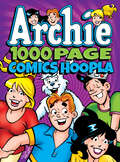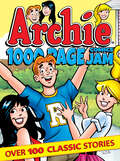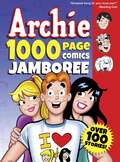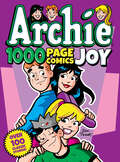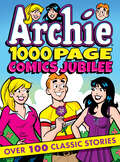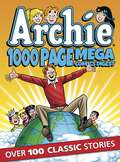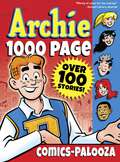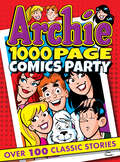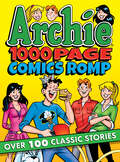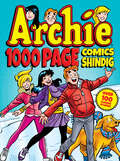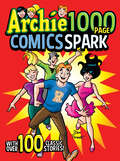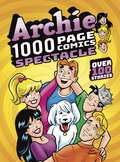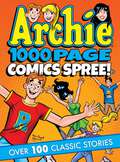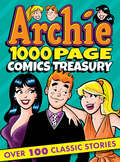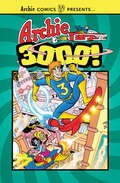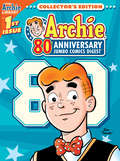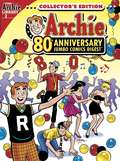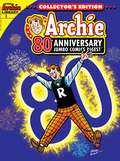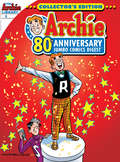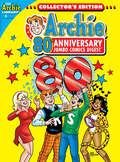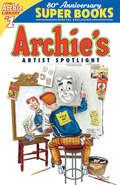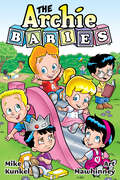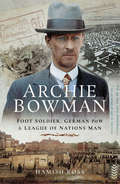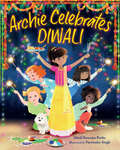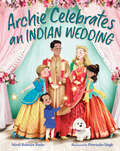- Table View
- List View
Archie 1000 Page Comics Hoopla (Archie 1000 Page Comics #16)
by Archie SuperstarsGet ready for the biggest collection EVER of the best and brightest stories Archie Comics has to offer! In this edition of the ARCHIE 1000 PAGE COMICS series, get ready for a HOOPLA of fun and entertainment with Archie!
Archie 1000 Page Comics Jam (Archie 1000 Page Comics #10)
by Archie SuperstarsARCHIE 1000 PAGE COMICS JAM collects 1000 pages of iconic Archie tales in this one amazing volume! Follow America's favorite red-head as he navigates the pressures of the American teenager in the awkward, charming, and hilarious way you've come to know and love.
Archie 1000 Page Comics Jamboree (Archie 1000 Page Comics #3)
by Archie SuperstarsGet ready for 1000 more pages of hilarious antics and iconic stories courtesy of Archie and the gang! From school shenanigans to dating disasters, Archie, Betty, Veronica, Jughead and the rest of the pals ‘n’ gals of Riverdale know how to make everyone laugh—and they’ve been doing a spectacular job of it for over seven decades! Celebrate everything Archie with the largest Archie collection series EVER offered at an incredible value price!
Archie 1000 Page Comics Joy (Archie 1000 Page Comics #22)
by Archie SuperstarsWe’re jumping with JOY over this newest collection of 100 hilarious and entertaining Archie stories!
Archie 1000 Page Comics Jubilee (Archie 1000 Page Digests #20)
by Archie SuperstarsThis volume collects 1000 pages of iconic Archie comic stories, featuring the same mix of wild humor, awkward charm and genuine relatability that has kept Archie and the gang popular with kids and families for over 75+ years.
Archie 1000 Page Comics Mega-Digest (Archie 1000 Page Comics #8)
by Archie SuperstarsARCHIE 1000 PAGE COMICS MEGA-DIGEST collects 1000 pages of iconic Archie tales in this one amazing volume! Follow America's favorite red-head as he navigates the pressures of the American teenager in the awkward, charming, and hilarious way you've come to know and love.
Archie 1000 Page Comics Palooza (Archie 1000 Page Comics #4)
by Archie SuperstarsArchie 1000 Page Comics Palooza is the latest volume of our biggest-ever collections, featuring over 100 full-color stories in a format similar to the hugely popular Archie Digest series at an amazing price! Follow America’s favorite red–head as he navigates the pressures of the American teenager in the awkward, charming and hilarious way you’ve come to know and love. Features the same mix of wild humor, awkward charm and genuine relatability that has kept Archie and the gang relevant for kids and adults alike for over 70 years. It’s 1000 pages of Archie fun at one low price!
Archie 1000 Page Comics Party (Archie 1000 Page Digests #20)
by Archie SuperstarsThis volume collects 1000 pages of iconic Archie comic stories, featuring the same mix of wild humor, awkward charm and genuine relatability that has kept Archie and the gang popular with kids and families for over 75+ years.
Archie 1000 Page Comics Romp (Archie 1000 Page Digests #19)
by Archie SuperstarsThis series is the #1 value in color children's books today. The latest volume of the biggest Archie graphic novels ever, featuring over 100 full-color stories in a format akin to the hugely popular Archie Digest series at an amazing price. Designed for mass market and book venues looking for higher price points, high volume and high value, such as warehouse clubs and book fairs.This volume collects 1000 pages of iconic Archie comic stories, featuring the same mix of wild humor, awkward charm and genuine relatability that has kept Archie and the gang popular with kids and families for over 75+ years.
Archie 1000 Page Comics Shindig (Archie 1000 Page Comics #12)
by Archie SuperstarsPut on your dancing shoes and head on over to a SHINDIG of your favorite Archie comic stories! In this edition of the ARCHIE 1000 PAGE COMICS series, get ready to laugh until your sides hurt and have as much fun as possible along with Archie & his pals ‘n’ gals! For 75 years, Archie and his friends have been making everyone laugh, with their dating hijinx and misadventures at Riverdale High School! Everything’s Archie in the largest Archie collection series EVER—offered at an incredible value price!
Archie 1000 Page Comics Spark (Archie 1000 Page Comics Spark #23)
by Archie SuperstarsThis collection of 1000 pages worth of classic and hilarious stories is sure to spark joy in every Archie fan’s life!
Archie 1000 Page Comics Spectacle (Archie 1000 Page Comics #31)
by Archie SuperstarsWe’ve got 1,000 more pages of good-natured high jinks and fun for our adoring fans! Archie and his friends create a SPECTACLE in this oversized collection of entertaining stories!
Archie 1000 Page Comics Spree (Archie 1000 Page Comics #14)
by Archie SuperstarsGet ready for a MARATHON of the best and brightest stories Archie Comics has to offer! In this edition of the ARCHIE 1000 PAGE COMICS series, get ready for hours of fun, laughter and entertainment with Archie & his pals ‘n’ gals! You’ll enjoy this SPREE of super entertaining stories! Everything’s Archie in the largest Archie collection series EVER—offered at an incredible value price!
Archie 1000 Page Comics Treasury (Archie 1000 Page Digests #17)
by Archie SuperstarsThis series is the #1 value in color children's books today. The latest volume of the biggest Archie graphic novels ever, featuring over 100 full-color stories in a format akin to the hugely popular Archie Digest series at an amazing price. Designed for mass market and book venues looking for higher price points, high volume and high value, such as warehouse clubs and book fairs.This volume collects 1000 pages of iconic Archie comic stories, featuring the same mix of wild humor, awkward charm and genuine relatability that has kept Archie and the gang popular with kids and families for over 75 years.
Archie 3000 (Archie Comics Presents)
by Archie SuperstarsARCHIE 3000 is the complete collection featuring the classic series. This is presented in the new higher-end format of Archie Comics Presents, which offers 200+ pages at a value while taking a design cue from successful all-ages graphic novels.Travel to the 31st Century with Archie and his friends! In the year 3000, Riverdale is home to hoverboards, intergalactic travel, alien life and everyone's favorite space case, Archie! Follow the gang as they encounter detention robots, teleporters, wacky fashion trends and much more. Will the teens of the future get in as much trouble as the ones from our time?
Archie 80th Anniversary Digest #1 (Archie 80th Anniversary Digest #1)
by Archie SuperstarsBRAND NEW DOUBLE-SIZED STORY: “Hundreds of Possibilities!” Archie takes a nap only to be awakened by someone pounding on his door. To his surprise, it’s his best friend Jughead—but not the Jughead he recognizes. This one belongs to something called the Time Police, and he comes with a warning: all the Archie space time continuum will soon be collapsed into one reality. Archie must join forces with Jughead to save the day—and all of time as we know it! This brand new digest series celebrates 80 years of Archie with the best stories lovingly handpicked by fans, beautiful art pages, and fun fan-centric bonus content. This is a must-have limited series featuring 8 decades-worth of the most hilarious and memorable Archie tales!
Archie 80th Anniversary Digest #2 (Archie 80th Anniversary Digest #2)
by Archie SuperstarsBRAND NEW STORY: “HAPPY ARCHIEVERSARY!” Archie’s lasted for eighty years—which means he’s undergone quite a few art changes and different style choices over those last eight decades! Let Archie guide you through this history of, well, Archie! But it turns out to be more than just a tour when the different eras of Archie come to life in this fun commemorative story!
Archie 80th Anniversary Digest #3 (Archie 80th Anniversary Digest #3)
by Archie SuperstarsBRAND NEW STORY: “Waterparked!” Betty, Veronica, Archie, and Jughead are excited because they are going to a waterpark for the day. Unfortunately when they get there the park is overcrowded and the lines are endless! Will their day at the waterpark be a big splash or will their idea of fun leave them all wet?
Archie 80th Anniversary Digest #4 (Archie 80th Anniversary Digest #4)
by Archie SuperstarsBRAND NEW STORY: “Pour Some Sugar, Sugar on Me!” The Archies have noticed that they haven’t been getting as many bookings lately, so they decide to shake things up! The only problem is that they each envision a new “path” for THE ARCHIES! Join them as they take a trip back in time and explore different musical genres and superstars and see if they can agree on what The Archies new sound and look will be!
Archie 80th Anniversary Digest #5 (Archie 80th Anniversary Digest #5)
by Archie SuperstarsBRAND NEW STORY: “Pep to the Future” Archie and Jughead are at the Riverdale Library when Archie finds an ancient text in a hidden compartment titled “Pep Comics no. 22.” Archie opens the book… and they’re both transported immediately back to 1941! Archie sees the iconic scene from Archie’s first appearance as Archibald “Chick” Andrews trying to impress Betty while standing on a bicycle. Unfortunately, Archie accidentally knocks Chick off the bicycle causing a rift in space and time. Riverdale characters and places from 2021 start to spill into 1941, and Jughead fears it could cause the end of the known universe! Can he and Archie restore the space time continuum and set things right? Find out in this fun lead story that concludes our 80th anniversary digest celebration!
Archie Artist Spotlight (Archie Comics 80th Anniversary Presents #17)
by Archie SuperstarsThis Artist Spotlight Superbook highlights the work of a few of our modern classic-style fan-favorite artists: Pat and Tim Kennedy, Jeff Shultz, and Rex Lindsey, along with highlighting the work of the many amazing writers, inkers, letterers and colorists that bring these timeless tales to life!
Archie Babies
by Mike KunkelArchie Babies, by Eisner Award-winning writer Mike Kunkel (Herobear and the Kid) and children&’s artist Art Mawhinney (Baby Looney Tunes, Rugrats) is Archie Comics&’ first-ever original graphic novel!After 70 years, Archie and his Riverdale gang have finally aged... backwards! In this exciting new book, you will follow Archie, Jughead, Betty and Veronica as they build friendships in Ms. Blossum&’s Wee Tots Nursery school, use their imaginations to go on adventures, and prove victorious over Fang, the class bully.
Archie Bowman: Foot Soldier, German POW and League of Nations Man
by Hamish RossIn 1915, Archie Bowman, a philosophy professor at Princeton, was granted leave of absence to join the British army. He served in the HLI and was captured at the Battle of the Lys.Prison camp, though, turned out not to be the living death he expected: he was fluent in German and became the main go-between with camp authorities and British prisoners; he gave talks to hundreds of prisoners, and wrote up in verse form his account of the battle and his capture and two-day march into captivity. When he was transferred to another camp, his writings were confiscated; but in his new camp his responsibilities increased, and he became key negotiator and formed a bond with the Commandant, a fellow academic, who secured the release of his confiscated work, which, when completed, was published as prison camp verses.After the Armistice, he was posted to the British Army of the Rhine in Cologne, where he found his most interesting work in the service, interviewing German civilians wishing to travel into another Occupied Zone.Although Bowman didnt become a pacifist he was convinced more could be done to prevent wars; and he dedicated himself to the cause of peace and championed the ideal of the League of Nations, at the cost of his health.Based on the archived Bowman Papers, it is a fascinating story of a man of high principle and great depth of feeling who had the love and support of his wife Mabel.
Archie Celebrates Diwali
by Mitali Banerjee RuthsIt's Archie's favorite holiday—Diwali. And this year she gets to share it with her friends and introduce them to the festival of lights!Archana loves her family's annual Diwali (deh-vah-lee) party, and this year she gets to share it with all her friends from school. She helps with the decorations and the food, and is eager for everyone to arrive. But once the party starts a thunderstorm kicks up and drenches the outside decorations and knocks out the power. Archie worries that everything will be ruined. How can there be a festival of lights without any electricity?
Archie Celebrates an Indian Wedding
by Mitali Banerjee RuthsKindhearted Archie is back! Her Poppy Uncle is getting married in a big Indian wedding, and Archie and new friend Emma realize that love and fun are universal.In this cross-cultural friendship story, Archie helps Emma, who isn&’t Indian, learn everything she needs to know when Archie&’s Poppy Uncle and Emma&’s Auntie Julie get married. The girls go to the mehendi party and sangeet together. They help Julie at the wedding, steal Poppy&’s shoes, and eat ladoos at the reception. Now Archie and Emma are friends—and cousins!Archie&’s adventures celebrate Indian culture! We first met Archie in Archie Celebrates Diwali and now join her in the follow-up Archie Celebrates an Indian Wedding. Backmatter in Archie's books feature kid-friendly resources to enrich the reading experience.
